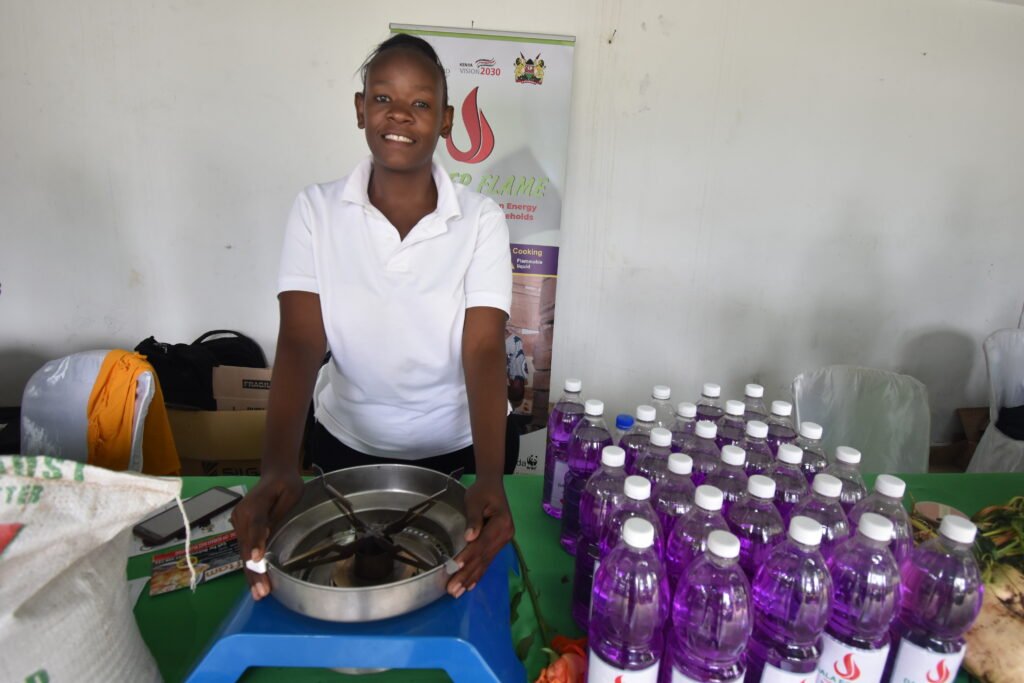By Zablon Oyugi
For fishermen in Lake Victoria, water hyacinth is a nuisance that hinders their fishing activities and causes them economic hardship. A study published in the East African Journal of Environment and Natural Resources in 2023 estimated that the invasion of water hyacinth in Kenyan lakes — including Africa’s largest lake, Lake Victoria — has led to annual losses of between $150 million and $350 million in Kenya’s fishing, transport and tourism sectors.
For innovators, however, the invasive plant has become a blessing in disguise. They are transforming it into an affordable alternative fuel for low-income households, providing a safe, healthy cooking energy source that poses no harm to people or the environment. One such innovator is Richard Arwa, a high school science teacher turned entrepreneur in Kisumu’s Ogango area.
Dala Ecofuel, a social enterprise Arwa founded, produces bioethanol from water hyacinth mixed with molasses, offering a safe and sustainable cooking energy solution. He has since named his budding enterpris e Dala Ecofuel, meaning home environment friendly cooking energy. How the idea came about Lillian Pedha, sales manager at Dala Ecofuel, says the eco-fuel idea came from a high school science congress competition in which Arwa participated and where his students showcased a project on the
potential use of some local plants as a source of fuel. It is from this project the science teacher picked the idea and would develop it into an enterprise which is now providing a cheaper and cleaner alternative fuel to households in lowincome neighbourhoods who rely on kerosene and wood fuel.
“Many of the science congress projects are potential solutions to some of the serious challenges facing many people in the society but in most cases they are forgotten at the competition level with no one to develop on them,” says Lillian.
“With this innovation, we have not only demonstrated how important these projects are but also indicate the importance of locally available materials in providing affordable products for slum areas such as Ogango village.” How bioethanol fuel is made The main raw materials for the production of the biofuel are water hyacinth and molasses.
Lillian says that from time to time they hire casual workers to harvest the invasive weed on Lake Victoria using boats. “They harvest the most succulent ones and bring it to our manufacturing site where it is weighed to process their payments,” she says. The production begins with the harvested water hyacinth being fed into a locally fabricated presser machine which separates the extract from the fibre.
While the fibres can be used to process animal feeds, the extract is mixed with molasses for fermentation, resulting in a flammable purple liquid bioethanol fuel, which is then tapped, collected and filled in containers for the market. “We sell a litre of the bioethanol fuel at Ksh100. This amount of the gas can support any cooking activity for four hours,” says Lillian. Safi-stove The bioethanol fuel burns from a locally made two-litre capacity stove called Safi-stove.
The fuel is poured inside the stove through an opening which is then tightly closed only to be released during cooking by a handle operator. “We make these stoves too so that we may provide a complete package of a cooking system to our customers at affordable price,” says Lillian.
“Firewood has become so expensive to find in slum areas so as charcoal and kerosene which produce dirty soot that can cause diseases to users, majority being our mothers and girls who handle cooking activities.” Cooking with firewood releases harmful smoke and fine particles, which can cause a range of health problems, especially respiratory illnesses.
yuzablon@gmail.com

